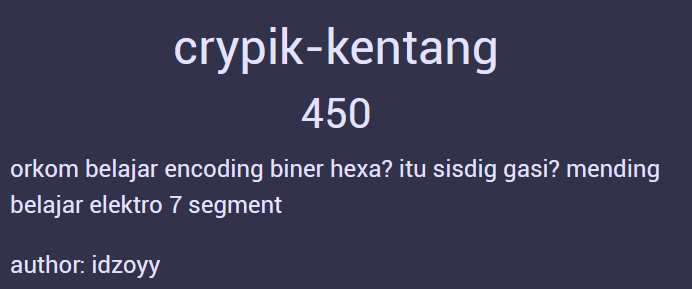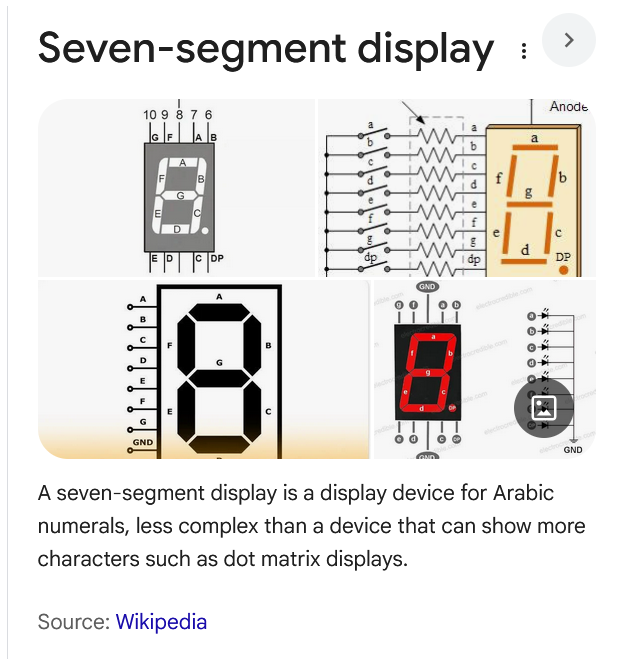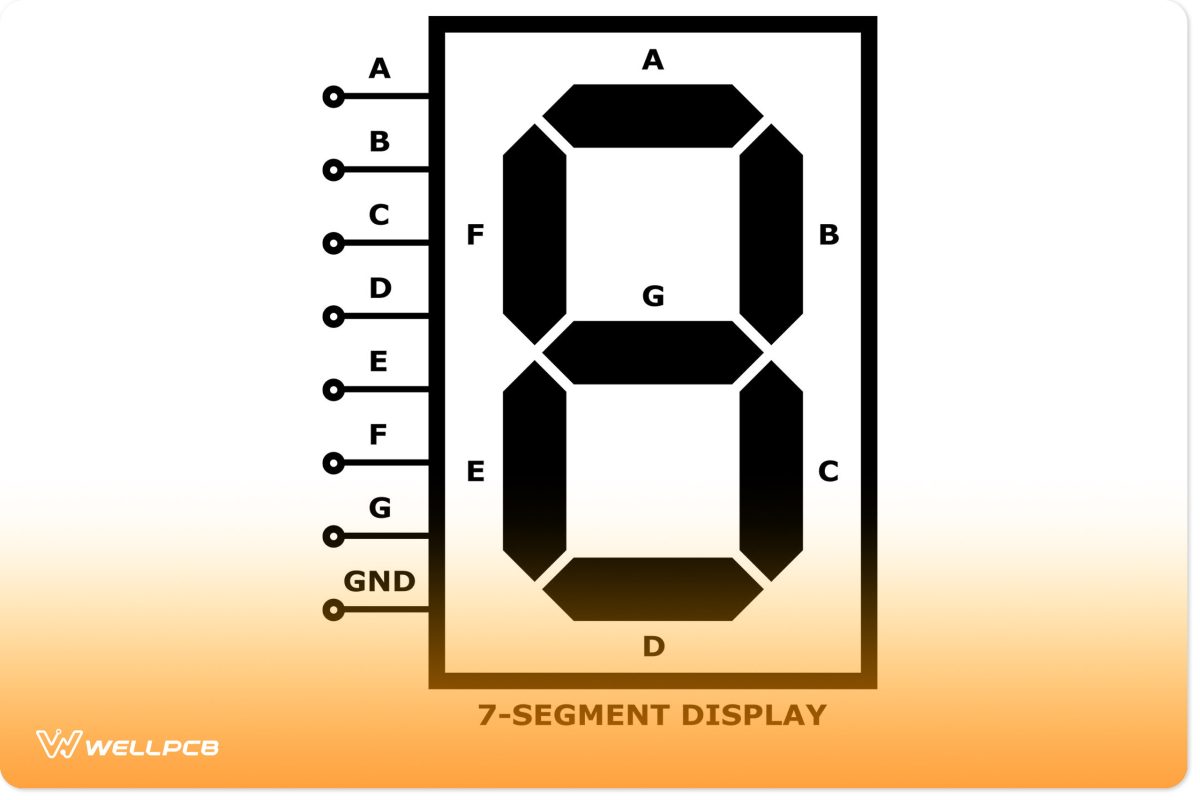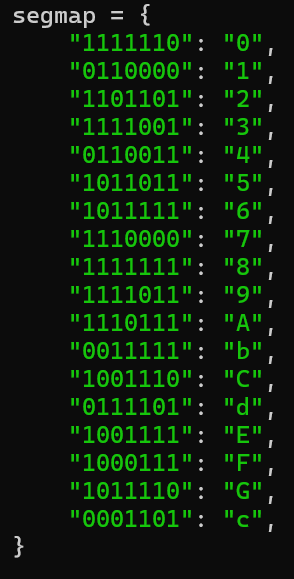crypik-kentang
Solved by: grb
This is what the challenge looks like, there's a text file attached with it. The challenge mentions something about "7 segment", I wonder what it is.

Lets check out the attached text file.

So, as you can see, there's a lot of what looks like a binary data, but each group of binary is only 7 bits instead of 8 bits like a normal binary, maybe this is because of the "7 segment" that the challenge mentioned? Lets find out what is 7 segment. A quick google search will result us with this.

Ahh, so its this thing huh, then how can we decrypt those bits into a understandable seven segment? I found this

So essentially, the first bit is A, the second bit is B, and so on and so forth. Obviously decoding bit by bit will take so much time so lets automate it! I created this translation mapping for the bits to readable characters in python.

# Mapping from 7-seg binary (A–G order) to characters
segmap = {
"1111110": "0",
"0110000": "1",
"1101101": "2",
"1111001": "3",
"0110011": "4",
"1011011": "5",
"1011111": "6",
"1110000": "7",
"1111111": "8",
"1111011": "9",
"1110111": "A",
"0011111": "b",
"1001110": "C",
"0111101": "d",
"1001111": "E",
"1000111": "F",
"1011110": "G",
"0001101": "c",
}
data = """1111101 1001111 1111101 1110001 1111101 1011110 0000111 0111111 1111101 1101111 0000111 1100110 0000111 1111100 1111101 0000111 0000111 0111111 0000111 1100110 1001111 1110001 1101101 1110001 1111101 0000111 1111101 1101101 1111101 1011110 1111101 1101111 1111101 1111001 1111101 1101111 1001111 1110001 1101101 1110001 1111101 1001111 1111101 1011000 1111101 0000110 0000111 1101101 1111101 1100110 1111101 1101101 1001111 1110001 1101101 1110001 1111101 1001111 1111101 1110001 0000111 0111111 1111101 1101111 1111101 1011000 1111101 1110001 0000111 1100110 1001111 1110001 1101101 1110001 1111101 1100110 1111101 1101101 0000111 0111111 0000111 1001111 1111101 1101101 1111101 1101101 1111101 1111100 1001111 1110001 1101101 1110001 1111101 1101111 1101101 1110001 0000111 0000111 1111101 1110001 0000111 1101101 1111101 1011000 1111101 1100110 1101101 1110001 0000111 1011011 1111101 1101101 0000111 1001111 0000111 0111111 1111101 1101101 1111101 1001111 0000111 1100110 1101101 1110001 1111101 1101111 1111101 1111101 1101101 1110001 0000111 1101101 1101101 1110001 1111101 1011110 1111101 0000110 1111101 1111001 0000111 1101101 1111101 0000110 1111101 1011000 1101101 1110001 1111101 0000110 1111101 1111001 1111101 0000110 1111101 1011000 0000111 1101111 0000111 1001111 1111101 1101111 0000111 1001111 1101101 1110001 0000111 0111111 1111101 1011000 0000111 1101101 0000111 1001111 1101101 1110001 1111101 1110001 1111101 1111001 1111101 1011000 1111101 1101111 1111101 1111001 1111101 1101101 1101101 1110001 0000111 1100110 1111101 1110001 1111101 1110001 1111101 1011000 0000111 1001111 0000111 1011110"""
# Decode
out = []
for b in data.split():
if b in segmap:
out.append(segmap[b])
else:
out.append("?")
decoded = "".join(out)
print(decoded)
But when i run it, I got a lot of non-matching bits.
?E???G??????????????E?2????2?G???3??E?2??E?????2???2E?2??E????????????E?2????2???E?2?2??E?2???2??????2????2??5?2?E???2?E??2?????2??22??G???3?2????2????3???????E???E2??????2?E2????3?????3?22??????????E?G
Hmmm... its weird, maybe... Lets try to flip the order of the bits. You can check out the working script here. And when I run it, I get this.
636F6d7069747b6770743F5F67656d696E693F5F636c617564653F5F636F70696c6F743F5F6465707365656b3F5F695F776F756c645F726573706563745F69665F755F6d616E75616c5F616E616c797369735F706c75735F6F6E6c696E655F746F6F6c737d
Converting these hex string will get us

PO- PO- PO- PWNED!!!